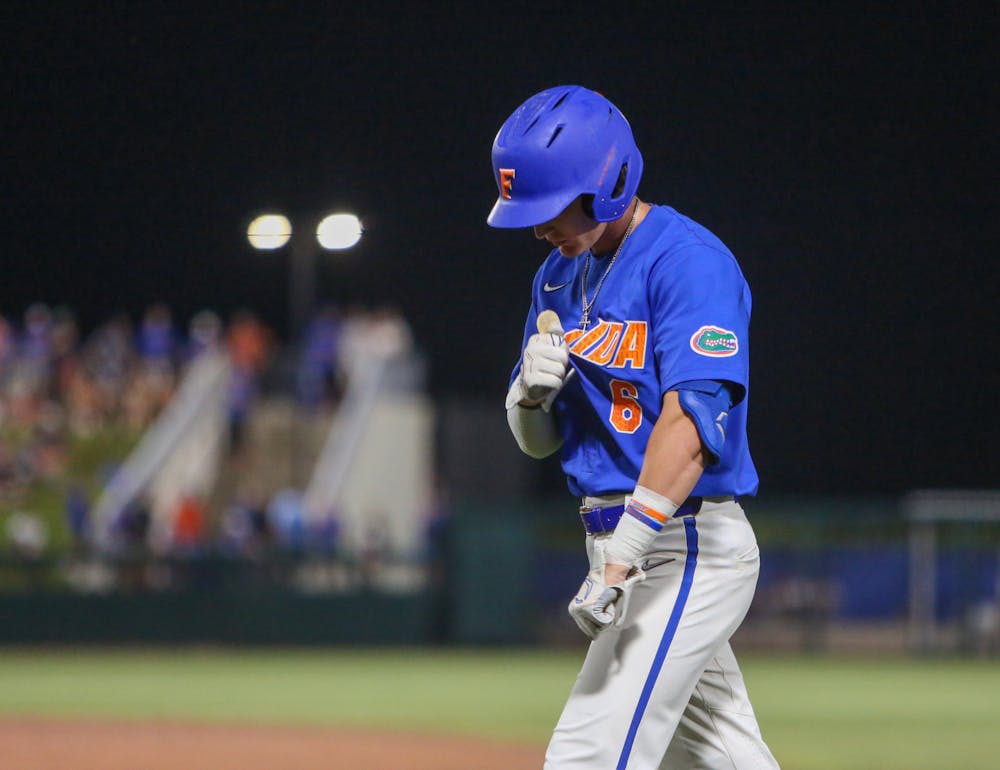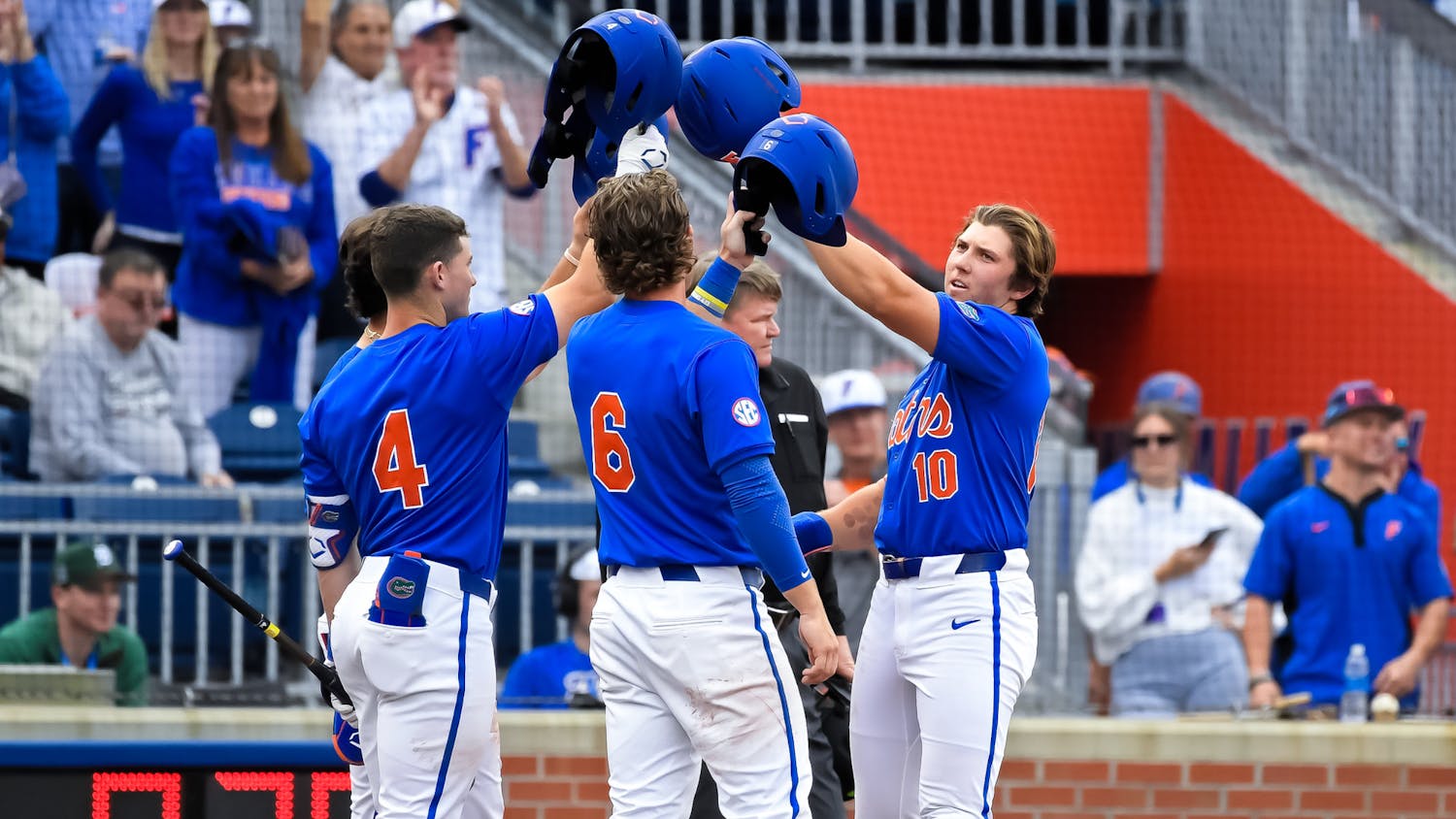The “if” was never a question for Gators junior outfielder Tyler Shelnut. That was until two weeks before his freshman season of college baseball.
Shelnut knew from a young age that he wanted to play baseball at UF. He grew up 30 minutes away from campus in Lake City, Florida, and he went to plenty of games as a child. When the program offered Shelnut a scholarship in the ninth grade, he didn’t hesitate to commit.
Three years later, an unexpected phone call from Florida forced him to reconsider his future just two weeks before his freshman season.
“‘There’s nothing we can do,’” Shelnut said the Gators told him. “‘Nobody got drafted. We have no space on the roster.’”
The MLB shortened its draft from 40 rounds to five in 2020 due to the COVID-19 pandemic. Players from Florida expected to be selected in the regular draft format returned to campus. The situation forced UF to rescind Shelnut’s offer.
It left him with two weeks to find a school to play for.
“Honestly, heartbroken is probably the best word I could put to that when it all happened,” Shelnut said. “It was my dream school. It was where I wanted to go. I was a fan of the school.”
Shelnut briefly weighed his options and contacted Santa Fe College head coach Johnny Wiggs. He was set to begin his collegiate career at SFC. It was close by, and Shelnut figured soon enough he’d get an opportunity to play at Florida or another Division I school.
“We were excited to have him,” Wiggs said. “We were able to bridge that gap for Shelnut and give him that opportunity to keep his dream alive.”
Shelnut couldn’t help but feel he wasn’t supposed to be there, he said.
“Going into Santa Fe, selfishly enough, you think ‘I’m better than this,’” Shelnut said. ”If you commit to an SEC school in ninth grade you don’t think you’re ever gonna play JUCO.”
His outlook quickly changed when difficulties were presented to him. Shelnut learned to swallow his ego at Santa Fe, he said.
“I learned how to grind and be grateful because, in JUCO, you show up to a field, you gotta get on a bus for three and a half hours at 4 o’clock in the morning,” Shelnut said. “There’s nobody in the stands but two people’s parents, and it’s 120 degrees or it might be 25 degrees. It’s always the worst conditions you could possibly imagine.”
Talks increased between him and other Division I schools as Shelnut approached the end of his junior college baseball stint. However, one errant pitch in the state championship game derailed his chances of moving to the next level for the upcoming season.
Shelnut was on the mound for the final inning of the game. He served as the Saints designated hitter and go-to reliever all throughout the year. Wiggs called Shelnut’s name trailing 8-5 in the eighth inning.
He knew something felt off in his leg after tossing a few pitches from the mound. Shelnut finished the inning and hobbled back to the dugout. Six days later, He was in the operating room getting surgery on a torn right hip labrum.
Doctors estimated it would be nine months before Shelnut could step foot back onto the field. The focus became whether or not he would play baseball at all.
“‘Is this what you wanna do?’” Shelnut asked himself. “If it is, you gotta buckle down and figure it out. If not, you gotta quit right now. And I was not about to quit.”
Two days after surgery, Shelnut crutched his way around the gym. He went every single day. Six months later, he returned to normal shape — three months before doctors thought he’d be ready.
Shelnut and Wiggs agreed he should shy his focus away from pitching during his sophomore season, Shelnut said. He was a serviceable two-way player, but his chances to advance to the next level were always going to be determined by his bat, Wiggs said.
Shelnut got off to a hot start his sophomore season and got the call he'd been waiting for the last two years.
Florida head coach Kevin O’Sullivan wanted him for next season.
“He’s just a good baseball player and he’s a terrific teammate, too,” O’Sullivan said of Shelnut after his Gators debut against Charleston Southern on Feb. 17, 2023. “I’m glad he’s in our program.”
It’s not often that O’Sullivan has looked toward junior college in search of players. Though, with the history between the two and Shelnut developing into an even better player during his time with the Saints, it seemed right to call, O’Sullivan said.
Everything made sense in Shelnut’s mind for him to return to the program, he said.
“The scholarship money is there,” he said. “It’s thirty minutes from my house. It’s where I wanted to go before … I just didn’t think that any other school was gonna be able to top that scenario. So, I decided to go back.”
Shelnut began his junior year with Florida as the team’s designated hitter. However, after some talks with O’Sullivan, the head coach decided the junior could be a valuable asset starting in right field.
It was Shelnut’s first time playing right field in his career, but the change didn’t affect his swing. In his very first start as a right fielder, he launched a three-run home run over the fence.
Shelnut quickly made the starting job his. Shelnut continued to prove himself behind his reliable bat. He hit .277 at the plate — the sixth highest average among starters on the team — and adjusted to playing right field smoothly. He committed only two errors throughout the season.
He served as a starter in all six of the Gators’ College World Series games in Omaha, Nebraska. UF fell in three games to Louisiana State in the CWS finale.
Shelnut looked back on his time at Santa Fe and called it the best thing to happen to him.
“It prepared me to play at UF, being there for two years,” he said. “I would recommend to anybody to go to that school. It was awesome. The coaches were awesome. I think it worked out perfectly.”
Shelnut went unselected in this year’s MLB draft and will return to Florida to play his final season of eligibility with the Gators.
Contact Luke Adragna at ladragna@alligator.org. Follow him on Twitter @lukeadrag.
Luke Adragna is a third-year journalism student and the Florida Gators football reporter at The Alligator. He is a cat ethusiast and completes the NYT Daily Mini in less than a minute each day.






